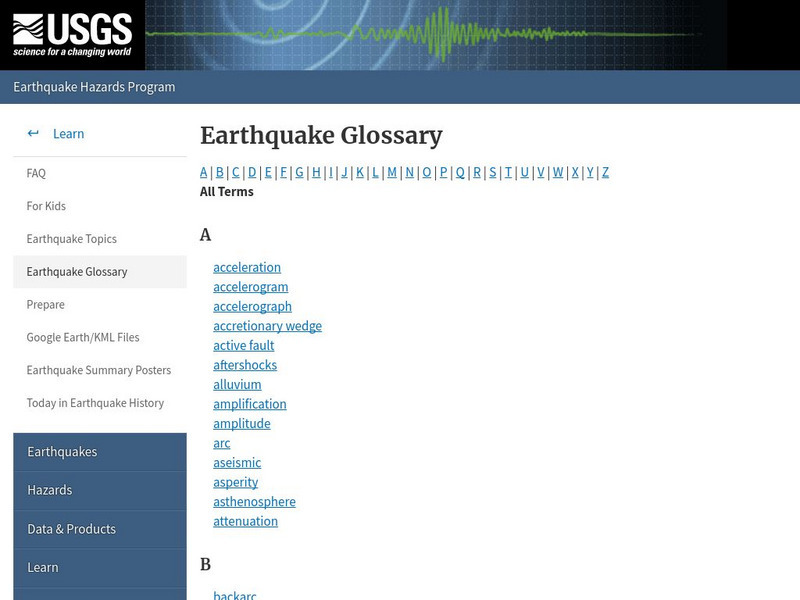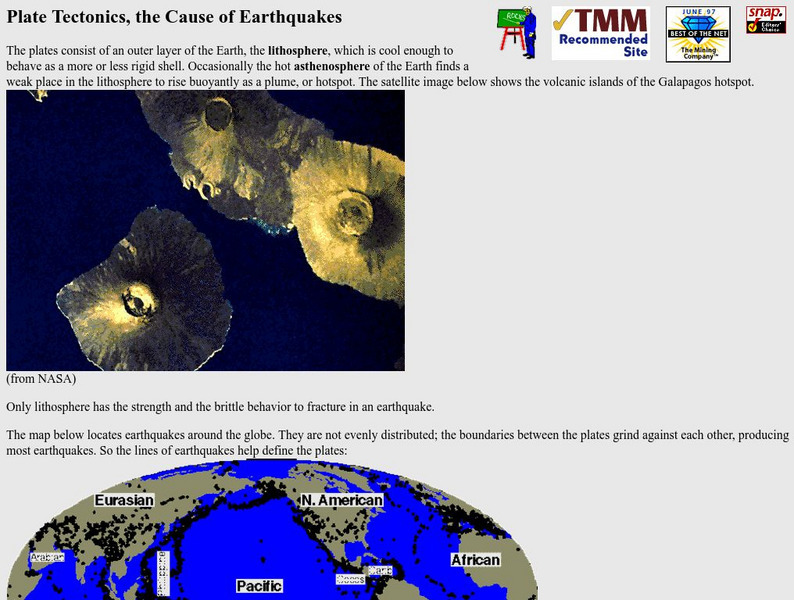Hi, what do you want to do?
Curated OER
Types of Faults
This set of black-line diagrams of the three different types of faults can be used with your upper elementary earth scientists. Simply have them color the layers to show where the land once lined up. Another use for this resource would...
Curated OER
What's Shaking?
In this Earth movements worksheet, learners compare and contrast earthquakes and volcanoes. Students write a short essay about the similarities and differences and then complete 4 matching questions.
Curated OER
Redefining an Earthquake
Ninth graders build an "Earthquake Machine" (a manipulative model of a fault line) and use it to explore stick-slip behavior of some faults and to develop a more accurate definition of an earthquake and its causes.
Curated OER
Earthquakes Rock!
Learners study the main methods to measure earthquakes; the Richter Scale and Mercalli Scale. They make a model of a seismograph and investigate which structural designs are most likely to survive an earthquake.
Curated OER
TRB 5:2 - Activity 3: Earthquakes
Learners watch a classroom demonstration, and experiment to discover the five ways that Earth's crust shifts along a fault.
Curated OER
The Big One
Eighth graders study earthquakes. In this earthquake activity students research the Internet on earthquakes and plot earthquake locations.
Curated OER
It's Not Your Fault
High schoolers study the San Andreas Fault, calculate its movements, and compare the movements on both sides. In this earthquake instructional activity students use the Internet to track movement, and calculate movement using a...
Curated OER
Curious? Quake Up!
In this "Curious? Quake up!" worksheet, students answer 4 multiple choice questions about earthquakes, interactively, then check their answers.
Curated OER
All Shook Up
Students measure movements in the Earth's crust due to seismic activity. Students calculate the amount of displacement in horizontal and vertical direction due to an earthquake.
Curated OER
GED Vocabulary: Earth and Space Science-Earth's Crust and The Solar System
In this earth and space science activity, learners complete a crossword puzzle given 9 clues and a word bank on topics such as sea floor spreading, tectonic plates, faults, lava and the big bang theory.
Curated OER
A Model of Three Faults
Students investigate faults. In this science instructional activity, students explore the many stresses and strains in the earth's layers and research the types of faults in their state.
Curated OER
Earth's Crust in Motion
In this Earth's crust worksheet, students will review the different ways the crust is moving including soil erosion and earthquakes. Students will complete 6 word scramble/fill in the blank, 3 multiple choice, and 11 short answer questions.
Curated OER
Science Word Search
In this science worksheet, students locate and identify various vocabulary terms related to earth science. There are 44 words/phrases located in the puzzle.
Curated OER
Earth Science--Letter "F"
In this earth science instructional activity, learners locate and identify vocabulary terms related to earth science that begin with the letter "F." There are 24 words located in the puzzle.
Curated OER
Active Faulting in Idaho
High schoolers use CAD maps to explore active faults in Idaho. Through observation of maps, they explore the layers of the Quaternary and Holocene faults. Individually, or in groups, they identify characteristics of faults such as...
Curated OER
Geologic Maps
Students explore geologic maps. They locate specified mountain ranges and faults on maps. Students compare and contrast the characteristics of mountain ranges and faults. They identify rivers, mountains and locate Z rocks.
Exploratorium
Exploratorium: Loma Prieta, Bay Area, Earthquake 1989
This outstanding multimedia site documents the earthquake and related events that took place on October 17, 1989 in the San Francisco Bay Area.
Exploratorium
Exploratorium: On the Road With the Faultline Project
This outstanding multimedia website follows the San Andreas fault system up the California coast from San Diego to just north of San Francisco on the coast.
US Geological Survey
Usgs: The San Andreas Fault
A great overall site that tells us about the San Andreas fault, where it is and what kind of movements have occurred. It then goes on to talk about earthquakes in general and their occurrences along fault lines.
Other
Tech Museum: Building for the Big One [Pdf]
This resource presents a project where students design and build structures that can withstand an earthquake. The project can include an extension where students look at the factors of soil type and proximity to fault in their design....
US Geological Survey
U.s. Geological Survey: Earthquake Center: Glossary
This resource provides definitions of important earthquake related terms.
Other
Nevada Seismological Laboratory: Plate Tectonics, the Cause of Earthquakes
This site contains an in-depth explanation of the causes of earthquakes as they relate to plate tectonics, and also has many nice and easy to read pictures, maps, and diagrams of plate tectonics and earthquakes.
Curated OER
National Park Service: Creating Flat Topped Mountains
The NPS offers a good overview of the forces that create a plateau and experiments to help students understand. Lesson plan.
Other
Digital Library for Earth System Education: Living in Earthquake Country
An inquiry unit that teaches students about the how and why earthquakes cause damage and about life in earthquake country. Students specifically learn about: earthquake damage, where earthquake occur, earthquake patterns, seismic waves,...
























![Tech Museum: Building for the Big One [Pdf] Lesson Plan Tech Museum: Building for the Big One [Pdf] Lesson Plan](http://lessonplanet.com/content/resources/thumbnails/411264/large/bwluav9tywdpy2symdiwmduymc0xmdm2my0xd3vtenpxlmpwzw.jpg?1589993199)


